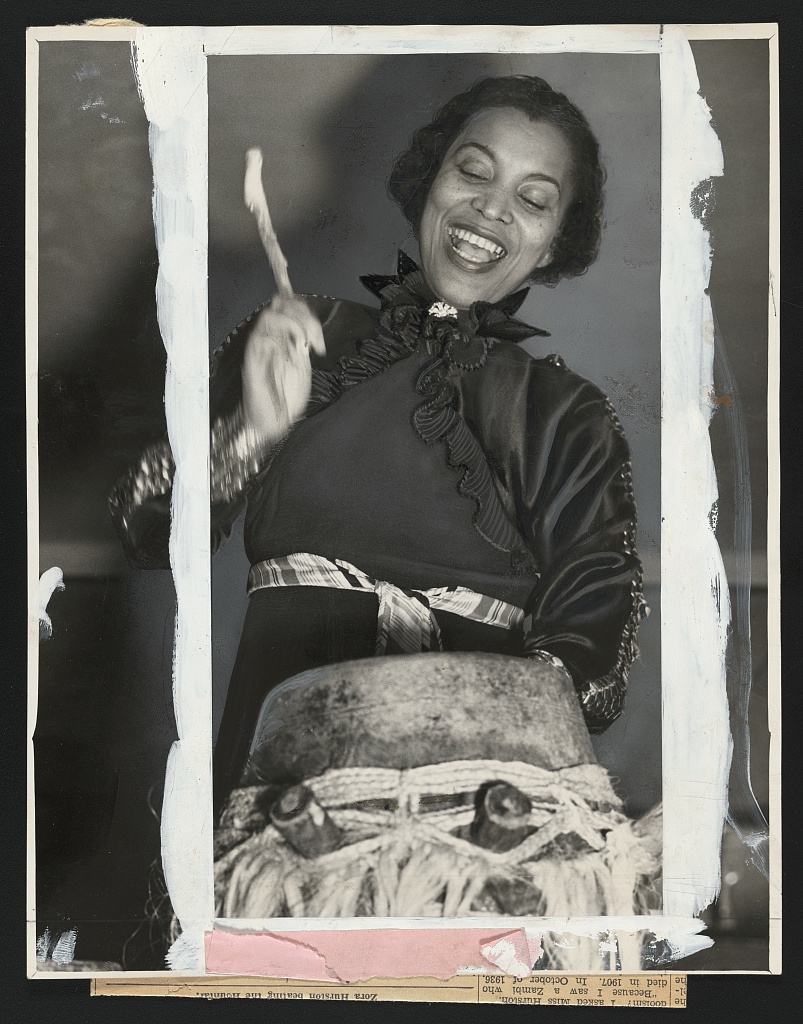A Florida Frenzy
On Zora Neale Hurston's “Crow Dance”
By Paul Reyes

New York World-Telegram staff photo, 1937. Courtesy Library of Congress
Folklore, the oral art, what Zora Neale Hurston called “the boiled-down juice of human living,” was in a wild, primordial phase when the WPA’s Federal Writers’ Project assigned her to record what she could of it in Depression-era Florida. Tales and songs were being chiseled out among the cultures that made up this motley state. The slippery legend of Daddy Mention, an unruly convict, was evolving among the prison work gangs of Duval County; the “hustling, chant ing stevedores and roustabouts” of Jacksonville had their own dark ballads; elders could recount the last “Indian fighters” retreating from the Panhandle; and from Tarpon Springs down through the Keys, you found a hothouse of Greek, African, Latin, and Caribbean cultures, largely unassimilated but coexisting, thriving with the still fresh, raw material of mother countries. “No other State in the Union has had the history of races blended and contending,” Hurston wrote in her proposal to chase these figures down; in Florida, she insisted, there was still “an opportunity to observe the wombs of folk culture still heavy with life.”
Reading about her research in the rural South, you begin to under stand how mythologically thick the region was. How vocally rich. Song rhythm cued the axe and hammer; storytelling interrupted the monotony of crickets. The way Hurston describes it, in one account or other, there was something fantastic about the landscape then. Hardly a day passed without someone at some distance breaking into song. Not a mild, civilized whistle, but loud song.
Collecting, for her, was an impulsive process. She’d overhear a song somewhere, track it down, get the formalities out of the way and dip herself into the music, absorb it, sing along until she could sing it on her own, take a few notes, and move on. Her senses were tweaked for the next moan or line rising from a yard or from around a corner, from a field or rail. This attunement—to voice, to song, to subtleties of expression, physical or tonal—was perhaps her finest skill.
Add to all this singing the risk of violence, rooted in a suspicion of outsiders. “Primitive minds are quick to sunshine and quick to anger,” she wrote. “Some little word, look or gesture can move them either to love or to sticking a knife between your ribs. You just have to sense the delicate balance and maintain it.” Measuring the heads of random passersby in Harlem (her first assignment as an anthro pology student at Barnard) must have taught her something about improvisation, about the ten-second window in which you earn or lose a stranger’s trust, because much of her song collecting was flat-out dangerous. Among the turpentiners and their murderous fore men, she found grim Conradian scenes where humanity had failed (while surviving, of course). On some nights, she collected songs through duets with men whose jealous women sought to cut her open. She carried a pistol, took no victims, but came awfully close to “old club-footed Death.” Her work was never dull. She ran with a tough woman named Big Sweet, learned hoodoo from a witch doctor named Frizzly Rooster. She boiled black cats. She painted lightning on her back.
In mid-June, 1939, she returned to Jacksonville with folklorist Herbert Halpert for a recording session at the Clara White Mission, where they invited rail workers, musicians, and grandmothers to share as many tales and songs as they could fit on tape. She prodded, choreographed, led a chorus, coached, but finally unleashed her own bright performances.
“Crow Dance” is one of them, which she likely picked up between South Florida and the Bahamas. She’d overheard West Indian migrant workers singing in Miami, late 1920s, and followed her ear to Nassau, where she joined every ceremonial dance she could, learned every move, and left with over a hundred songs, a film (now lost), and the raw material for her folk revue, The Great Day, which played off Broadway for a while in 1932.
“Crow Dance” involves a dancer at the center of a circle, imitating the sacred African buzzard as it stoops, eats, and flies away. Zora knew the buzzard’s part cold, and probably showed a step or two that afternoon in Jacksonville. The songs she delivered there make for a catalogue of lost culture you could easily, and pleasantly, lose your self in (the Library of Congress has at least a dozen that feature Zora in the lead). There’s the gambling song, “Let the Deal Go Down Boys,” the jumpy “Halimuhfask” (Halifax), “Shack Rouser,” and the bawdy “jook” song “Uncle Bud” (“Oh little cat, big cat, little bitty kittens / Goin’ to work their tails if it don’t start fittin’ ”), at the end of which, the starchy Halpert adds, “I think that was a very valuable contribution to scientific recording.”
Halpert may have blushed, but you can bet Zora didn’t, and we can consider ourselves lucky she ramrodded through any prudish hesitation, because the song, like every other—shaped by Zora’s loud, high-pitched, diva-of-the-shower warbling—preserves a species of joy and rhythm, a paradise regained every time you sing it.


